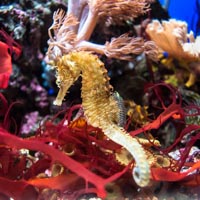Dried seahorse in traditional medicine: A narrative review

Accepted: 5 September 2021
All claims expressed in this article are solely those of the authors and do not necessarily represent those of their affiliated organizations, or those of the publisher, the editors and the reviewers. Any product that may be evaluated in this article or claim that may be made by its manufacturer is not guaranteed or endorsed by the publisher.
Seahorses are classified as members of Syngnathidae family, which includes pipefishes, pipehorses, and seadragons. China, including Hong Kong, uses 250 tons of seahorses as Traditional Chinese Medicine (TCM) every year. It is popular in Traditional Medicines (TM) especially TMC and its derivatives. The TCM formulations of dried seahorse strengthens the kidney and enhances immunity to treat the aging process. Base on the molecular biology analysis, S6 ribosomal protein gene, S7 ribosomal protein gene, and the S20 ribosomal protein gene have been identified in dried seahorses, which help to reduce the cough symptoms. The present mini-review discusses the background of the use of dried seahorses, the TCM theory, the TCM formulations, the molecular biology, and analysis of its usage in traditional medicine.
Lourie SA, Pritchard JC, Casey SP, et al. The taxonomy of Vietnam's exploited seahorses (family Syngnathidae). Biol J Linnean Soc 1999;66:231-56. DOI: https://doi.org/10.1111/j.1095-8312.1999.tb01886.x
Foster SJ, Vincent ACJ. Life history and ecology of seahorses: implications for conservation and management. J Fish Biol 2004;65:1-61. DOI: https://doi.org/10.1111/j.0022-1112.2004.00429.x
Lourie SA, Foster SJ, Cooper EWT, Vincent ACJ. A guide to the identification of seahorses. Project Seahorse and TRAFFIC North America. Washington D.C.: University of British Columbia and World Wildlife Fund, 2004.
Ried K, Stuart K. Efficacy of Traditional Chinese Herbal Medicine in the management of female infertility: A systematic review. Complement Ther Med 2011;19:319-31. DOI: https://doi.org/10.1016/j.ctim.2011.09.003
Bensky D, Clavey S, Stoger E. Chinese herbal medicine: Materia Medica, 3rd edition. Seattle: Eastland Press, 2004.
Meng XQ, Xu DH, Mei XT. Research on Hippocampus capsule therapy of experimental benign prostatic hyperplasia. Chin Pharm J 2005;40:190-3.
Zhang CH, Ni QG, Wu LY. Studied on antitumor activity of Trachyrhamphus serratus. China Marine Drugs 1998;4:10-2.
Aung SK, Fay H, Hobbs RF. Traditional Chinese Medicine as a Basis for Treating Psychiatric Disorders: A Review of Theory with Illustrative Cases. Med Acupunct 2013;25:398-406. DOI: https://doi.org/10.1089/acu.2013.1007
Gross T, Nischt R, Gatermann K, et al. Primary structure of the ribosomal protein gene S6 from Schizosaccharomyces pombe. Curr Genet 1988;13:57-63. DOI: https://doi.org/10.1007/BF00365757
Cecconi F, Crosio C, Mariottini P, et al. A functional role for some Fugu introns larger than the typical short ones: the example of the gene coding for ribosomal protein S7 and snoRNA U17. Nucleic Acids Res 1996;24:3167. DOI: https://doi.org/10.1093/nar/24.16.3167
Chan HY, Zhang Y, O'Kane CJ. Identification and characterization of the gene for Drosophila S20 ribosomal protein. Gene 1997;200:85-9. DOI: https://doi.org/10.1016/S0378-1119(97)00378-8
Chang CH, Liaw NHJ, Lin YS, et al. Authenticating the use of dried seahorses in the traditional Chinese medicine market in Taiwan using molecular forensics. J Food Drug Anal 2013;21:310-6. DOI: https://doi.org/10.1016/j.jfda.2013.07.010
Koning S, Hoeksema BW. Diversity of Seahorse species (Hippocampus spp.) in the International Aquarium Trade. Diversity 2021;13:187. DOI: https://doi.org/10.3390/d13050187
Zhang N, Xu B, Mou C, et al. Molecular profile of the unique species of traditional Chinese medicine, Chinese seahorse (Hippocampus kuda Bleeker). FEBS Lett 2003;550:124-34. DOI: https://doi.org/10.1016/S0014-5793(03)00855-X
Wang X, Zhong H, Guo J, Hou F. Morphology and molecular identification of the zoological origin of medicinal seahorses in Chinese herbal markets. Mitochondrial DNA Part A 2020;31:335-45. DOI: https://doi.org/10.1080/24701394.2020.1815719
PAGEPress has chosen to apply the Creative Commons Attribution NonCommercial 4.0 International License (CC BY-NC 4.0) to all manuscripts to be published.


 https://doi.org/10.4081/idhm.2021.158
https://doi.org/10.4081/idhm.2021.158



